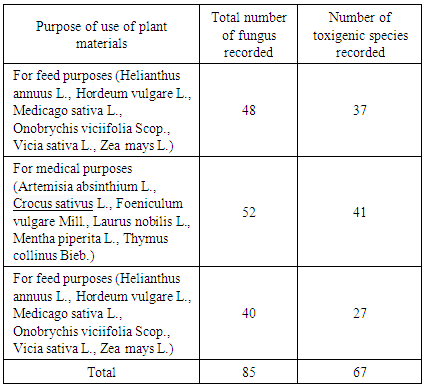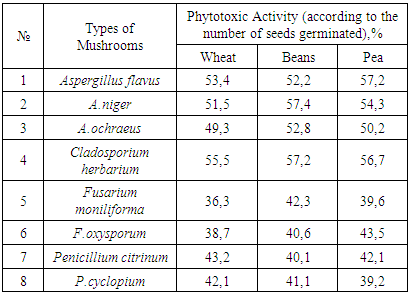-
Paper Information
- Paper Submission
-
Journal Information
- About This Journal
- Editorial Board
- Current Issue
- Archive
- Author Guidelines
- Contact Us
Advances in Life Sciences
p-ISSN: 2163-1387 e-ISSN: 2163-1395
2019; 9(1): 7-10
doi:10.5923/j.als.20190901.02

Evaluation of Some Plant Materials Used for Feed, Food, and Medical Purposes by the Species Composition of Toxigenic Mycobiota and Frequency of Occurrence
Bakhshaliyeva K. F.1, Muradova S. M.2, Mammedaliyeva M. Gh.3, Namazov N. R.4, Jabrailzade S. M.2
1Institute of Microbiology of ANAS, Azerbaijan, Baku and Institute of Fruit and Tea-Making of the Ministry of Agriculture of the Republic of Azerbaijan
2Azerbaijan State Pedagogical University, Baku, Azerbaijan
3Azerbaijan State Economic University (UNEC), Baku, Azerbaijan
4Sumgayit State University, Azerbaijan, Sumgayit, Azerbaijan
Correspondence to: Bakhshaliyeva K. F., Institute of Microbiology of ANAS, Azerbaijan, Baku and Institute of Fruit and Tea-Making of the Ministry of Agriculture of the Republic of Azerbaijan.
| Email: |  |
Copyright © 2019 The Author(s). Published by Scientific & Academic Publishing.
This work is licensed under the Creative Commons Attribution International License (CC BY).
http://creativecommons.org/licenses/by/4.0/

The purpose of the present work was dedicated to the study of toxigenic fungi by species composition, by the dominant species of fungal biota and their frequency of occurrence which involved in the formation of mycobiota of materials of some plants used for feed, nutritional and medical uses in Azerbaijan. In research, from the analysis taken from plants become clear that in the formation of their mycobiota in generally involved 85 species of fungi and 76,5% of them have toxicity. It became clear that fungi such as Aspergillus flavus Link, A.ochraeus K. Wilh., Cladosporium herbarium(Pers.) Link, Fusarium moniliforma J. Sheld., F.oxysporumSchltdl., Penicillium citrinum Thom andP.cyclopium Westling are the dominant species of the mycobiota of all studied plant materials. The obtained results can be useful as base data in the preparation of the principles of mycology safety in the use of plant materials for food, nutrition, and medical purposes.
Keywords: Plant, Different purpose, Mycobiota, Toxigenic species, Frequency of occurrence, Phytotoxic activity
Cite this paper: Bakhshaliyeva K. F., Muradova S. M., Mammedaliyeva M. Gh., Namazov N. R., Jabrailzade S. M., Evaluation of Some Plant Materials Used for Feed, Food, and Medical Purposes by the Species Composition of Toxigenic Mycobiota and Frequency of Occurrence, Advances in Life Sciences, Vol. 9 No. 1, 2019, pp. 7-10. doi: 10.5923/j.als.20190901.02.
Article Outline
1. Introduction
- As known, living things for the continue their activities constantly adopts various substances from the environment, and throw out their secret products. The production of nutrients used by living things, primarily by humans, is generally carried out in an open environment and this covers all stages of production. Under these conditions, interact of invisible creatures, such as microorganisms with these materials are inevitably and naturally, microorganisms are considered natural contaminants of plant, animal origin, and raw materials [5,11] and these characteristics are also compatible with the metabolites they form at the end of their life activities [1]. Both the microorganisms themselves, which are the natural contaminants of plant materials used for medicinal purposes such as food and feed, and the metabolites they form are characterized by a wide spectrum of diversity [2,11]. Whether microorganisms, or their metabolites, are negatively characterized, or are less harmful to the health of other living beings, are not small [9,20].Among the mushrooms which are adversely affected by life, toxigenic is the center of special attention. Though the toxigenic species of fungi (mushrooms) are still known to humans long ago, learning of the toxins they synthesize ran into the 60s of the last century [4,18]. The reason for this is therefore that the fungi that have these properties are the main pathogenicity factor leading to efototypes, which is due to the toxins they synthesize. It should be noted that toxigenic microscopic fungi are broad and heterogeneous according to their mutual morphological manifestations, nutritional and reproductive capacities, localities, developmental histories, and pathological effects of living organisms [2].The richness of the Azerbaijani nature has spurred the widespread spread of mushrooms here and, therefore, a considerable amount of time, translating them into predominantly exploratory studies [7]. Even though these researches are not enough to precisely characterize the microbiota specific to the nature of Azerbaijan, they can also be characterized as systematic mycological studies. This idea is not to say about toxigenic fungi, so that only the toxigenic fungi are found among the fungi that are spread in the studies carried out.For this reason, the toxigenic type composition in the formation of microbiota of various plant materials used for various purposes by making Azerbaijan is presented as an aim to define the dominant biota of general fungi.
2. Materials and Methods
- As a research object, it is used as a research object in the Azerbaijani conditions in terms of feed, food and medicinal were toxigenic fungi that formed in the microbiotics of the plants (Artemisia absinthium L., Crocus sativus L., Cucumis sativus L., Cucurbita pepo L., Foeniculum vulgare Mill., Helianthus annuus L., Hordeum vulgare L., Laurus nobilis L., Medicago sativa L., Mentha piperita L., Onobrychis viciifolia Scop., Phaséolus vulgáris L., Pisum sativum L., Solánum tuberósum L., Thymus collinus Bieb., Triticum L., Vicia sativa L., Zea mays L.) materials used for the purposes. For the isolation of fungi were used both plants (grown on nature) and their dried masses.In all cases, rice agar (DA), potato agar (KA) were used from the standard nutrient media [6,15], malted water (ASS), Capek medium (ACM). It was also used during the hiding of workers' cultures from these nurturing environments.During the identification of fungi taken to the pure culture from noted nutritional mediums were used determinants compiled based on cultural-morphological and physiological signs [12,18,20]. The system of fungi has been used and named in the official site of the BMA [8].The frequency of occurrence of fungi is determined by P = (n / N) X 100 formulas. Here, the frequency of occurrence of fungi (or the rate of spread of the pathogeninergic disease with -%) in the P - samples, n - the number of fungi detected (number of plant individuals caught in the investigated territory, number), and the overall number of N - specimens Total number).The phytotoxicity of the individual fungal species involved in the mycobiota of the materials investigated during the course of the study was tested during the germination of wheat, beans, chickpeas and barley seeds. For this, a certain number of (100-150) seeds of each plant were used. The fungi are filtered for 5 days in a dry Capek environment, and the resulting biomass is removed (KM). The seeds used are placed in the same KM-de flour for 24 hours. Control is being used on sterile Capek. The seeds are then placed on the moistened filter paper and placed for sprouting for 7 days at room temperature (20-22°C). The phytotoxic activity (% - le) of the fungi is determined according to the formula P = (n / N) X100, in which case P-phytotoxic activity represents the number of n-germinated seeds and N - represents the overall number of seeds taken.To compare the suitability of the individual microshenes, the serenity type compatibility ratio (K) was used [14]:K=2C/A+BHere, the number of species A and B - each senescence is the number of the same species in the senescence where C is constant.All experiments were carried out at least 4 times and the results were statistically analyzed according to known methods [7]. In all cases, the results that responded to the formula m / M = P≤0.05 (where P -Styudent criterion, M- middle indicator, m- medium square regression) were honestly calculated and included in the dissertation.
3. He Results and Their Expression
- It is understood from the results that the plant materials which are kept for various purposes are also characterized as one in the fungus settlements and they differ from each other in the type contents of the fungi in the formation of the mycocomplexes (table 1). As seen, 78.8% of the fungi involved in the formation of the mycobiota of forage products contain toxigenic fungi. The same indicator in the mycobiota of plants used for the food and medical purposes contain 75,0% and 67,5%. This is due to the difference in the biochemical composition of these plants.
|
|
4. Conclusions
- Thus, it is understood from the records made that the material used for various purposes (feed, food and medical) by making Azerbaijan is also one of the settlement places of fungi and Aspergillus flavus, A.ochraeus, Cladosporium herbarium, Fusarium moniliforma, F.oxysporum, Penicillium citrinum and P.cyclopium, and the frequency of occurrence is between 45.5-57.2% and phytotoxic activity is between 36.3-57.2%. The high content of toxigenic fungi on plants used for food, feed and medical the purpose makes it necessary to develop and strictly adhere to mycology safety Principles for Using These Products. The obtained results useful as database information for the work to be done in this area.
 Abstract
Abstract Reference
Reference Full-Text PDF
Full-Text PDF Full-text HTML
Full-text HTML
